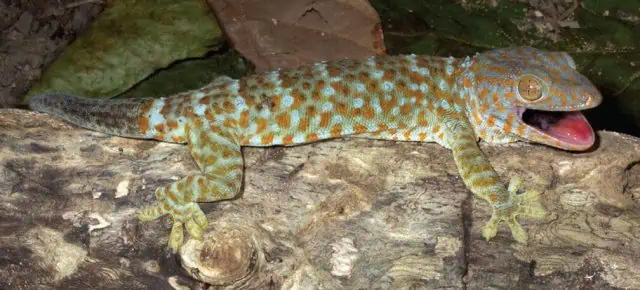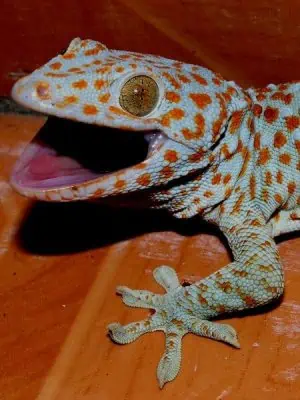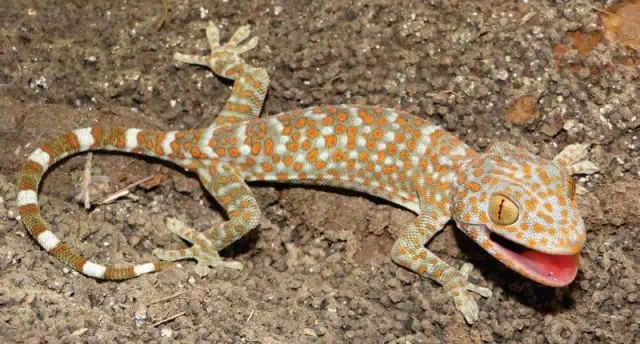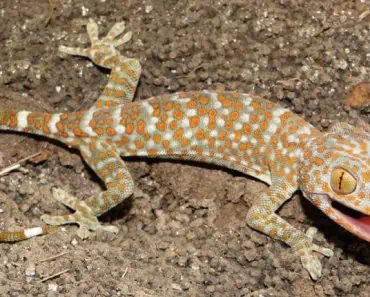
Despite the aggressive side that Tokay Geckos are widely known for, they do need a pair to live a happy life. Some Tokay Geckos might be very easy to pair so you won’t have anything to worry about. But you need to keep an eye on the picky ones.
Pairing two Tokay Geckos can turn very bad very fast. But it can be done if you’re a little experienced. What you should keep in mind is that you should never place a new Tokay Gecko in another’s enclosure “until you set the new enclosure up”.
How well your Tokay Geckos will get along while being housed together depends on you as well.
Tokay Geckos Living Together – How Many? Males or Females?
Many people love having one single Gecko as they are a little easier to maintain than a pair. And if you’re a beginner or you’re planning on getting one for your child, starting with one Gecko is a smart choice.
But when it comes to housing them together, you need to be very careful. Tokay Geckos are extremely territorial. If you put two Tokays that don’t like each other together for a night until morning one of them will be dead.
You can house up to three Tokay Geckos together and there can never be more than one male. Their territorial behavior will make them extremely aggressive to each other even if they’re siblings.
On the other hand, females tend to accept one another better if they’re siblings. If they’re also strangers at first, you will need a lot of work to make peace between them. Having a very big enclosure is always the key.
If you want to add another female to a pair that already bonded with each other, they might both gang up on the new female to get her out of their enclosure. You need a lot of patience to make it work.
You should also keep in mind that although two males can never be housed together, two females can live very well in the same enclosure. The key is to never have a Gecko that’s much bigger than the other. Otherwise, the small one will end up as food for the bigger Tokay Gecko.
Can a Tokay Gecko live together with a different type of lizard?

Tokay Geckos are a little bit difficult to house together at first, but they can end up getting along very well with each other. One thing they can’t do is accept another type of lizard in their enclosure.
They are very territorial and seeing another lizard in their home can make them panic and get very aggressive. Unlike pairing two Tokay Geckos together, making one accept another type of lizard is impossible.
It also doesn’t make a difference if the new lizard is male or female. The Tokay Gecko will start a fight and one of them will end up dead if you’re not around.
Another thing you need to keep in mind is that trying to introduce them during the day won’t make any difference. The reason why they might not fight during the day is that they’re nocturnal beings. Once the night falls, you will need to be there to pick them apart.
Can you feed Tokay Geckos when they’re together?
Feeding Tokay Geckos is fairly easy if you have the right type of food. Unless you’ve been starving them, they won’t attempt to kill one another over a bug if another one is available.
You can feed the pairs while they’re together. But you need to introduce enough food for both or all three of them at once. Otherwise, you will start a war between them over the food.
When it’s time to feed them, so might eat from the scissors while others wait for you to let go of the cockroach. To avoid any fights between them, you can attempt to make a little bit of distance so they won’t try to go for each other’s bug.
Generally, Tokay Geckos are pretty easy to feed and you will rarely have any problems with them if there’s enough food to go around.
Where do you keep them when you have 2 or more?
If you end up with two males, you will need to make two separate enclosures as fast as possible. A 20-gallon tank should be enough for one Tokay Gecko. But an enclosure that’s 18in x 18in x 24in for each of them is the best choice.
When it comes to two females, you can introduce them to each other and attempt to house them together. For two Tokay Geckos, you will need an enclosure that’s at least 24in x 18in x 36in.
Keep the females under very close observation for some time. If you notice them getting aggressive with each other even after weeks of living together, you’ll have to tear them apart. Otherwise, they might live happily in the same enclosure.
No matter how many males you have, they always need to be housed apart. And the females should only be housed in pairs of two. The best way to pair them is a male with a female or a male with two females.
Reproduction of the Tokays in close quarters
The breeding season of Tokay Geckos starts in late October and runs through May. Within this time, there’s a wet season in Indonesia. It’s highly recommended to add extra misting when there’s a local thunderstorm as rain is a great breeding trigger.
Females lay two eggs one month after breeding. And she will continue to do so every 30 days until she has 6 or 8 eggs. What you need to keep in mind is that the male needs a separate enclosure after the female lays her second or third set.
If the male is not removed, the female will keep laying legs which can exhaust her mineral reserves. This can quickly result in egg binding because of kidney failure.
Tokay babies – How they do around adults

There are many lizards that eat their little ones. However, Tokay Geckos are not among them. The only reason why a Tokay would eat a baby Gecko is if he or she senses that they’re not the parent.
The same goes for their eggs. Males will eat the eggs that they can tell are from another male. And the female will only eat the infertile ones. Otherwise, Tokay Geckos are great parents.
Tokay Geckos will take care of their little ones until they’re around 10 months old. That’s when they go off alone and you’ll need to get the young ones their own enclosures.





